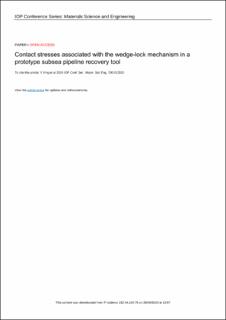| dc.contributor.author | Xing, Yihan | |
| dc.contributor.author | Eriksson, Nicolai Bull | |
| dc.contributor.author | Ong, Muk Chen | |
| dc.contributor.author | Knutsen, C. | |
| dc.date.accessioned | 2023-01-26T11:24:51Z | |
| dc.date.available | 2023-01-26T11:24:51Z | |
| dc.date.created | 2019-11-26T13:44:44Z | |
| dc.date.issued | 2019 | |
| dc.identifier.citation | Xing, Y., Eriksson, N. B., Ong, M. C., & Knutsen, C. (2019, November). Contact stresses associated with the wedge-lock mechanism in a prototype subsea pipeline recovery tool. In IOP Conference Series: Materials Science and Engineering (Vol. 700, No. 1, p. 012020). IOP Publishing. | en_US |
| dc.identifier.issn | 1757-8981 | |
| dc.identifier.uri | https://hdl.handle.net/11250/3046579 | |
| dc.description.abstract | This paper examines the contact stresses associated with the wedge-lock mechanism in a prototype subsea pipeline recovery tool (PRT) through numerical methods and experimental testing. The prototype PRT studied combines IK-Norway subsea plug technology in a subsea PRT. This allows the PRT to seal the subsea pipeline while it is being retrieved. The PRT can then flush the pipeline before retrieval and therefore providing for operational cost savings. This paper presents the first stage of the study which the sealing mechanism is not studied. The current wedge-lock mechanism uses a cone to press steel balls against the insides of the subsea pipeline thereby locking the PRT to the pipeline. Designing for sufficient contact stresses is critical to ensure that the PRT can grab the subsea pipeline tightly in order to ensure a successful recovery. The contact pressure distribution between the ball and cone in the wedge-lock mechanism is modelled using finite element method in Ansys. The resulting indentation depths occurring at the pipeline are compared against physical tests. It was found that the contact problem associated with the wedge-lock mechanism is complex and the actual contact stress/final gripping force is sensitive to the input parameters. Second, the results show that the Ansys numerical model is able to represent the contract stresses fairly accurately if the friction coefficient is well-controlled. Third, it was observed that a low friction coefficient ensures low indentation depths. Last, the results highlight that an increase in the cone-angle leads to a decrease in the indentation depth. | en_US |
| dc.language.iso | eng | en_US |
| dc.publisher | IOP Publishing | en_US |
| dc.rights | Navngivelse 4.0 Internasjonal | * |
| dc.rights.uri | http://creativecommons.org/licenses/by/4.0/deed.no | * |
| dc.title | Contact stresses associated with the wedge-lock mechanism in a prototype subsea pipeline recovery tool | en_US |
| dc.type | Peer reviewed | en_US |
| dc.type | Journal article | en_US |
| dc.description.version | publishedVersion | en_US |
| dc.rights.holder | The authors | en_US |
| dc.subject.nsi | VDP::Teknologi: 500 | en_US |
| dc.source.pagenumber | 12 | en_US |
| dc.source.volume | 700 | en_US |
| dc.source.journal | IOP Conference Series: Materials Science and Engineering | en_US |
| dc.source.issue | 1 | en_US |
| dc.identifier.doi | 10.1088/1757-899X/700/1/012020 | |
| dc.identifier.cristin | 1752488 | |
| cristin.ispublished | true | |
| cristin.fulltext | original | |
| cristin.qualitycode | 1 | |

